Tewkesbury Races
Early Years
to Expand
Every year, in the month of March, Cheltenham is host to The National Hunt Festival, a premier horse racing meeting that attracts over 50,000 spectators a day. To the regret of some Tewkesburians, and to the great relief of others, the town of Tewkesbury might have been the venue for this event had it not been for the frequent flooding that occurs around the town and the opposition to racing of some persons in positions of authority. Nevertheless, Tewkesbury was an important centre of horseracing in the past; the sport taking place on the Severn Ham.
The Ham is ancient meadow land situated to the west of Tewkesbury between the Mill Avon and Severn River. A right to the proceeds from the second mowing of the meadow on the Ham, known as the ‘aftermath’, was historically held by resident freemen of Tewkesbury and the occupiers of houses fronting the three principal streets of the town: High Street, Church Street and Barton Street. In 1808, an Act of Parliament was passed whereby The Trustees of the Tewkesbury Commons were appointed to be responsible for the division of the proceeds of the aftermath among those entitled under these rights,[1] a responsibility they still hold today. These trustees were also to play a part in the eventual demise of racing in Tewkesbury.
Some form of horseracing had no doubt taken place in England for many years, but the earliest record of organised racing is at York in 1530. Horseracing in its early days was a more informal affair compared to modern day racing. The meetings were regional or county gatherings; the only national meeting was at Newmarket, patronised by King Charles II.
Racecourses were not permanent establishments, and the courses that the horses followed were not necessarily well defined. All of the races were flat races; jump racing did not take place until the mid-19th century. Prizes were often awarded after the running of a number of heats. Two horse ‘matches’ were also quite common and many of the horses competed in more than one race. Many of the spectators would be on horseback themselves, galloping up the course behind the race and presenting what must have been a fairly chaotic spectacle.As well as Tewkesbury, there are records of racing in Gloucestershire in the 18th century at Gloucester Meads, Tetbury and Minchinhampton – all long before the first event at Cheltenham in 1815. The earliest record that we have of the Ham being used for horseracing is from 1721. In that year the Prince of Wales (later King George II) gave a gold cup worth 50 guineas[2] that was contested over Tewkesbury Ham on 2 September and won by a horse belonging to John Bridges.[3]
Tewkesbury Races:- On Thursday the first day of September, next, will be run for on Tewkesbury Ham, in the County of Gloucester, a Purse of Twenty Guineas … To be shewn and enter'd at the Swan in Tewkesbury the Thursday before … a Subscriber to pay Half a Guinea, and all others One Guinea and half, or double Entrance at the Post … And on Friday, the second Day of September, will be run for a Purse of Ten Guineas, by Galloways … The Horses to be kept from the Day of Entrance to the Day of Running, in some publick Stable.[5]
Growth & Society
to Expand
By the end of the 18th century things were more organised. A handbill advertising 'Tewkesbury Races', to be held over two days in August 1795, shows that handicap systems were in use based on age and gender of the horses as well as their previous form. Sweepstakes carried an entry fee of ten guineas (£10.50), a not inconsiderable sum in those days.[6] Samuel Ricketts was Clerk of the Course, to whom names of the horses and subscriptions were to be passed. As was usual, in conjunction with the races, a meal at a fixed price and time known as an ‘ordinary’ was arranged for each day: at the Swan Inn on the first day and at the Hop Pole on the second. Public breakfasts and balls in the evenings were also advertised.[7] It is clear that the races were an important event for the town and no doubt very good for trade. This is illustrated in 1795 by the 'town of Tewkesbury' adding to the prize money of one race 'a fox’s head, value ten guineas'.
The Gloucester Journal certainly thought this meeting a great success describing it in part as follows: "The brilliancy of the atmosphere; the aggregate female beauty of this ancient borough and environs (almost proverbial) with the accidental display from Cheltenham; rendered, the surrounding picturesque scene truly compleate [sic]." [8]
The article goes on to list the triumphs of Mr. Ram’s Hearty Cock, Capt. Snell’s Jaynetta, William Colston’s Sarah and Lord Donnegal’s For Andrews. It also alludes to critics of the races “… the unwearied attempts of a few individuals to put a lasting period to the Races at Tewkesbury.” Such opposition was to continue to surround the races in the future.
The London Times in 1805 reported on the races held at Tewkesbury in September of that year and gives some idea of the standing of the event:
These races were attended by a great deal of fashionable company from Cheltenham, and the surrounding villas, with which this beautiful part of Gloucestershire and the borders of Worcestershire abounds. There was most excellent sport, and everything went off with great eclat. These races bid fair to be the first in this part of the country, which the well known liberality of the Steward, Richard Cresswell, Esq. will always ensure. [9]
The rich upper classes were certainly well represented at the Tewkesbury Races. Mary Yorke of Forthampton Court wrote many letters in the late 1700’s and early 1800’s and she mentioned the races several times. She often had guests to stay who attended the races and the accompanying balls.
Bennett tells us that racing at Tewkesbury was discontinued between 1813 and 1824, then resumed in 1825 and took place regularly, except for 1829 due to flooding during the autumn.[10] The races appear to have been discontinued again during the 1830’s. They again resumed on 15 October 1841, formally entitled The Tewkesbury and Gloucestershire Races.[11]
A handbill advertising the 1843 meeting shows that at least one race was over hurdles. Entries and stakes were to be made to the Secretary at the Sun Inn. The race ordinary was arranged for Tuesday 18 July at the Swan Hotel and, for the Wednesday, at the Cross-Keys Hotel. A ball was to be held at the Town Hall, gentleman’s tickets 10/-, ladies 7/6d. (refreshments included). Admission of carriages and stage-coaches to the course cost 4/-, flys, phaetons and gigs 2/6d, saddle horses 2/-, jockeys to pay 2/6d. for weighing.[12]
Bennett gives a full account of this 1843 Tewkesbury meeting,
… on the 18th and 19th of July, on the Tewkesbury course, which is beautifully situated on the banks of the Severn, and is thought by many sporting men to be one of the best flat pieces of racing ground in the kingdom. On the morning of the 18th, the weather, which had been remarkably fine for some time before, looked ominous for a change; as the day advanced the clouds grew darker; towards noon it rained in torrents, and continued with but little intermission throughout the two days. Still, despite the ungenial weather, the attendance was numerous and respectable. An immense number of persons from Cheltenham were present; this was occasioned by the facilities afforded by the Railway Company, who had special trains, carrying any number of passengers, for a shilling each way; and it was calculated that at least two thousand persons availed themselves of this quick and cheap mode of transit. The Ham presented a bustling and animated scene: there was the ‘Ascot Grand Stand,’ (belonging to Mr. Barnard, of Epsom, and which had been conveyed hither by rail for the occasion,) on one side, and the lesser stand of the judge, (Mr. Clarke, of Newmarket,) on the other; a line of nearly twenty shuttling booths, each holding out its tempting sign, was ranged on each side of the grand stand, and an extended line of carriages, of all descriptions, was drawn up to the ropes on the opposite side; there was also a roomy temporary theatre, with numerous other exhibitions; and two roulette tables were placed near the grand stand, where you might play for ‘any sum from one shilling to fifty pounds.’ There was also a goodly show of ‘pea and thimble’ men, on the first morning, but as full half a score of their tables were speedily demolished, and the owners thereof somewhat rudely treated, the others soon disappeared.[13]
A number of illustrious personages presided at the meeting. The stewards were the Duke of Beaufort, Viscount Maidstone and William Dowdeswell Esq. M.P. However, Sir William Codrington, Bart. officiated for the Duke of Beaufort, who was unavoidably absent. Mr. Charles Halford of Tewkesbury was Secretary, Mr. Clarke of Newmarket was Judge and the Clerk of the Course was Mr. Nathaniel Chandler jun. of Tewkesbury.
In 1844 Bennett reports that the weather was very hot, and that the condition of the ground on the course was subsequently very firm going, with many of the races run in a canter until the final stages. He mentions that Barnard’s ‘grandstand’ was brought from Epsom for the event and that it was “well filled with respectable company: underneath it were placed commodious tables, amply furnished with tempting refreshments”.
Crime & Accidents
to Expand
As well as attracting royalty and other prominent members of society the races were also frequented by less respectable elements. The London Times in 1793 gives an insight into this more disreputable side of racing:
In 1843 two thieves were arrested on the Ham on the first race day, one for picking pockets and the other for stealing shoes. They were tried next day and sentenced: the former to six months’ imprisonment, the latter to four. Lamenting the absence of racing at Cheltenham in that year, the Cheltenham Journal newspaper reported on the Tewkesbury Races, “… the Ham displayed a goodly assemblage of company; there were noble lords, gallant knights, ladies gay, and ladies quite the reverse …” [21]
Also in 1843 a small steam locomotive was allowed to haul passengers to and from the town. One of these trains, driven by the company's locomotive superintendent, failed to stop at Tewkesbury station, crossed the High Street and went down the Quay branch, fortunately just coming under control as it was about to plunge into the river.[22]
In 1844 the deaths of three individuals occurred at the same time as the races. Two drowned in the Severn during race week. One was a youth named Gardener, a native of Nottingham, drowned near the Avon’s Mouth. The second, a local tailor named Woodward, drowned while bathing near the Upper Load. The third death was of a Henry Oldridge aged 21, he was found dead in his room at Twyning following a day at the races. There was an accident at Coombe Hill: the shaft of a gig broke and one of the passengers travelling from the races received serious injuries from a kick by the horse.
'Turfites'

Among lists of winning trainers at Tewkesbury Races the name of John Day often appears. John Day, who was nicknamed 'Honest John', looked like a serious clergyman, disapproved of smoking and always carried a black cotton umbrella. Prior to being a trainer he was a successful jockey; his granddaughter Kate was the great-grandmother of the jockey Lester Piggott. John Day is recorded as the owner of winners at Tewkesbury Races, but in fact it is more likely that the true owner was Lord George Bentinck. In around 1835 John Day became the trainer for Bentinck and together they bred and trained the most successful racehorses in the country. However, they did eventually fall out and part company.
Bentinck was considered a handsome dandy of his time. He was over six feet tall, dressed in the height of fashion, and wore a new satin scarf of cream colour every day at a cost of 5/-. A frock coat and a tall beaver hat completed his costume, although his racecourse attire consisted of a green coat, top boots and buckskin breeches.
Although he spent most of his time on racing, Bentinck had become M.P. for King’s Lynn in 1828. He then sat in Parliament for 18 years without speaking once. Then suddenly in 1846 he became heavily involved in launching attacks on Sir Robert Peel and the Free Traders and became a close friend and ally of Disraeli. His new intense involvement in politics led him to dispose of his racehorses. He sold his stable of 208 thoroughbreds for the very cheap price of £10,000. His biggest unfulfilled ambition in racing had been to own a Derby winner. It is ironic that following the sale of his horses, one of them, Surplice, won it in 1848. However, his disappointment must have been reduced by his winning £11,000 in bets on the race.
Opposition
to Expand
It may well be that the discontinuation of Tewkesbury races was a consequence of horseracing being introduced at Cheltenham. The first races there took place in 1815 on Nottingham Hill above Bishop’s Cleeve. Three years later the first meeting on Cleeve Hill occurred, and in 1819 the first Gold Cup was run. It was a flat race for three year olds and upwards with a prize of 100 guineas: it was won by Mr. Bodenham’s Spectre. Cheltenham races did not move to the present Prestbury site until the end of the 19th century.
I believe that there are periods of the day and night, yea even of the Sabbath day, when the heathen festivals of Venus and Bacchus are exceeded upon a Christian race ground …. numbers of the most worthless members of society flow in from every part of the country to partake in the unholy revelry, and to increase the amount of crime and guilt which is chargeable upon us. And it is scarce possible to turn our steps in any direction without hearing the voice of the blasphemer, or meeting the reeling drunkard, or witnessing scenes of the lowest profligacy. …. Gambling is the very essence of the amusement; though it be a vice which is more pre-eminently destructive both of body and soul than any other that Satan ever devised for the ruin of mankind.[25]
Such is the frightful catalogue of crimes that you are reckless enough to enumerate against a very large portion of the public by whom Races are frequented, at a time too when your Sovereign has stood forth to give them his sanction.…Picture the groups of fair, innocent, and happy females, borne in their gay equipages along the brow of Cleeve-hill, and say to what extent the ‘bloom of virtue’ has been violated by that excursion.[26]
Opposition to the races at Cheltenham reached a climax in 1829 when Rev. Close led protest demonstrations at the course where rocks and bottles were thrown at the horses and riders. In the following year the grandstand on the course was burnt down by arsonists, thought (though never proved) to be supporters of Rev. Close. This event ended racing at Cheltenham for fifteen years until it resumed in 1845. In the same year, Rev. Close was made life trustee of Trinity Church, Tewkesbury; no doubt his views concerning the races had support in the town.
to Expand
The Town was disgraced by scenes of the most defiling and degrading description: Riot and Debauchery; Drunkenness, Fornication and Lewedness; Quarrelling and Fighting; Cursing, Swearing and Filthy Talking were the painful and too evident fruits of the RACES! …. Hundreds of prostitutes, and hundreds more of the most infamous characters – swindlers and sharpers, thieves and pick-pockets – were let loose upon the population to pollute and plunder them! [27]
Demise of Tewkesbury Races
to Expand
Bennett also comments on the meetings held in 1847 and 1848. However, the lack of further accounts, and the absence of newspaper reports in following years, indicates that during the 1850s horseracing at both Tewkesbury and Cheltenham died out, or at least reduced considerably in importance.
An effort was made in 1870 to revive racing at Tewkesbury. The Ham Trustees, consisting of Messrs. F. Thomas, Spurrier, Osborne, Boughton, Smart, Jenner, Garrison and Prosser, and the Mayor, gave consideration to a letter received from Mr. Holman of Cheltenham. It asked for the consent of the trustees to the holding of two days’ races on the Ham at the end of October. However, their decision was negative and a resolution was passed stating, “That it is inexpedient to sanction the holding of horse races on the Severn Ham at the present time.” [29]
A final unsuccessful attempt to resurrect the event was made in the late 1880s. A petition was presented to The Trustees of the Tewkesbury Commons asking that restrictions in the letting of the Ham should be lifted and that the Ham be made available to public competition for its use. The document asserted that, “… prohibiting the use of the Ham for Race Meetings is detrimental to the interests of the persons entitled to the proceeds of such letting and to the interests of the trade of the town generally”. The petition, signed by 'The Burgesses and Ratepayers of the Borough of Tewkesbury', has around 150 signatures; among them those of William Allard, surgeon and J.P., Arthur Dowdeswell, J.P., and many of the shopkeepers of Tewkesbury.[30]
Meanwhile jump racing was developing ‘in fits and starts’ around Cheltenham. There was steeple chasing at Prestbury in 1847 but a cessation came in 1853 when Prestbury Park was sold to an owner opposed to racing. For some years there were steeplechases at various local locations such as Bibury and Andoversford. There was jump racing at Kayte Farm in Southam until a grandstand collapsed in 1866 injuring many people. After this racing appears to have ceased in the area.However, in 1881 Mr. W. Baring Bingham purchased Prestbury Park and announced his intention to revive the races there. He erected rails around the course, built a grandstand, and in 1898 held a race meeting there. Four years later, in 1902, the meeting that now dominates the jumping calendar was inaugurated on the current site in front of a large crowd. In 1924, the first Gold Cup Steeplechase was run, won by Red Splash. The rest is – of course – history.[31]
References
- James Bennett, The History of Tewkesbury, (1830).
- £52.50 – worth about £4,100 in modern values.
- Geast Charity Book, GRO: D2688, The History and Antiquities of Tewkesbury, (1798).
- Tewkesbury Register, 22 Feb 1890.
- No.1468. The Weekly Worcester Journal is the oldest weekly newspaper in Great Britain, having been first issued in 1690.
- Worth around £563 in modern values.
- Gloucestershire Archives, SP30.
- Gloucester Journal, 31 Aug 1795.
- Times, 25 September 1805.
- James Bennett, The History of Tewkesbury, (1830).
- James Bennett, Tewkesbury Yearly Register and Magazine for 1841.
- 10/- = 50p, 7/6d = 38p, 1/- = 5p, 6d. = 2 ½ p. £1 was worth c. £43 in modern values.
- James Bennett, Tewkesbury Yearly Register and Magazine for 1843.
- James Bennett, Tewkesbury Yearly Register and Magazine for 1844.
- Fashionable – the latest mode.
- A sharper (swindler).
- Times, 5 Sep 1793.
- Times, 28 Sep 1805; Gloucester Journal, 30 Sep 1805.
- Ancestry, Criminal Registers 1791-1892.
- Worcester Journal, 28 Nov 1811.
- Cheltenham Journal, 24 Jul 1843.
- Colin C. Maggs, Branch Lines of Gloucestershire, (Sutton Publishing, 1991).
- Worth about £62 in modern values.
- Francis Close (1797-1882) later Dean of Carlisle (Dean Close School in Cheltenham is named after him).
- Cheltenham Library, 63G 798.4.
- as above.
- Courtesy of Wendy Snarey.
- James Bennett, Tewkesbury Yearly Register and Magazine for 1844.
- Tewkesbury Register, 10 Sep 1870.
- Gloucestershire Archives TBR A 17/7.
- Peter Gill, Cheltenham Races, (Sutton, 1997).
Programme and Rules for the races in 1721
In August 1721, such was the fame of the Tewkesbury Races that the Stamford Mercury, in Lincolnshire, ran a detailed run-down of the programme and the rules.“ON Tuesday the 29th of this Instant August, will be run for in the Ham near Tewkesbury Gloucestershire, by the Direction of the Rt. Hon. the Earl of Essex, a Purse of 45 Guineas, by any Horse, Mare, or Gelding, (that never won any Royal Plate) carrying 10 Stone weight, with Bridle and Saddle, the best of 3 Heats, the Horses, &c. to be enter'd with Mr. Thomas Hale, Clerk of the Race, at the Town hall in Tewkesbury 4 Days before the Day of Running (which Day shall be deem'd one) each Contributor paying One Guinea Entrance, if no Contributor 3 Guineas; all which shall go the Town Plate to be run for the Friday following.
“And on Wednesday the 30th, will be run for on the same Course the Ladies Plate of about 20l. Value, by any Horse, &c. that never won the Value, or reputed Value of 30l. in Plate, or Money, at any one Time, carrying 11 Stone weight; the Horse to be enter'd as above. The Winning Horse, &c. to be Sold for 401. to the next best Horse (if demanded) each Horse, &c. to pay One Guinea Entrance to go to the Town Plate. “And on Thursday the 31st will be run for a Brace of Bucks, by any Horse, &c. carrying 12 Stone weight, the best of Heats. And on Friday the 1st Day of September following, will be run for on the same course, the Town Plate of about 20l. Value, by any Horse, &c. carrying 12 Stone weight with the Bridle and Saddle, the Winning Horse to be Sold for 30l.
“And on Saturday the 2nd of September, will be run for a Gold Cup of 50 Guineas Value, given by his Royal Highness the Prince of Wales, by any Horse, &c. carrying 11 Stone weight, with Bridle and Saddle, to be enter'd above. “N. B. All the Place or Rates are to be subject to the several Articles, and all Disputes referr'd to the Determination of the Right Honourable Samuel Molyneux, Esq; his Royal Highness the Prince of Wales's Secretary.”


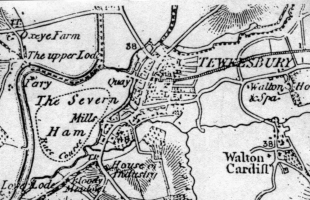
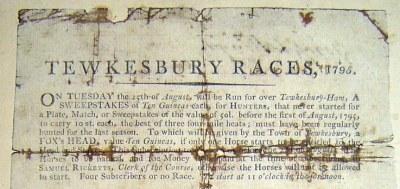
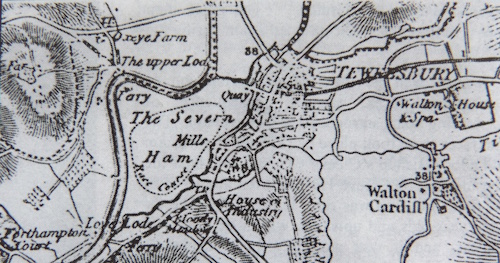
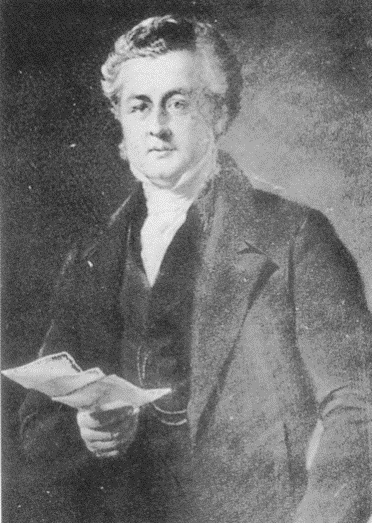
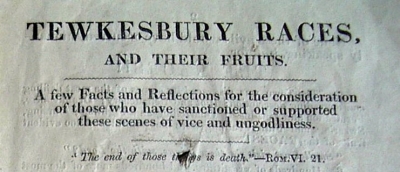
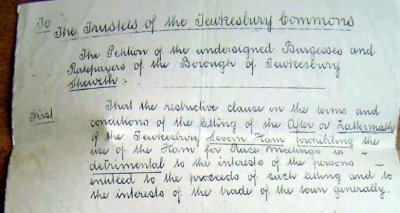
Comments